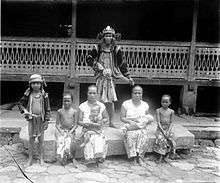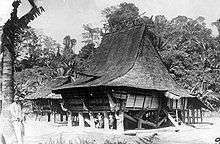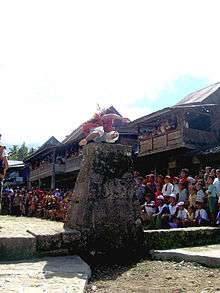Nias people
|
A photograph of two Nias warriors in South Nias Regency, circa 1892–1922. | |
| Total population | |
|---|---|
| (1,041,925 (Census 2010)) | |
| Regions with significant populations | |
| Nias Island, Indonesia | |
| Languages | |
| Nias language | |
| Religion | |
| Protestant Christian (predominately) 73 %,[1] Roman Catholicism 20%, Islam, Animist | |
| Related ethnic groups | |
| Batak people, Chinese, Malay people |
Nias people are an ethnic group native to Nias, an island off the west coast of North Sumatra, Indonesia. In the Nias language, the Nias people are known as Ono Niha; which literally means 'descendants of human'. While Nias island is known as Tanö Niha, where Tanö means 'land' in the Nias language.
The Nias people are a community that still actively living within the norms and practices of the indigenous culture. Customary law of the Nias people is generally referred to as fondrakö, which regulates all aspects of life from birth to death. Historical evidence of megalithic structures and carvings of stones that are found in the interior of the island proved that ancient Nias people practiced megalith culture. The caste system is also recognized in Nias society, whereby the highest level out of the 12 levels in the Nias caste system is Balugu. In order to reach this level of the caste, one must be able to carry out big festivals by inviting thousands of people and slaughtering of thousands of pigs for several days.
Origins
Mythology

According to the people of Nias, one of the mythical origins of Nias tribe comes from a tree of life called Tora Sigaru'a which is located at a place called Tetehöli Ana'a. According to the myth, it is said that the arrival of the first human on Nias island began in the days of King Siaro, whose nine sons had been banished out of Tetehöli Ana'a for fighting over the throne. Hence the nine sons of King Siaro were considered as the first people to set foot on the island of Nias.
Archaeological observations

Archaeological observations have been conducted on Nias island since 1999. The observations has found that human habitation on the Nias island has been since 12,000 years ago through migration from mainland Asia to Nias island during the Paleolithic period. In fact there are indications of this migration as far as 30,000 years ago. During that period there is only Hòa Bình, Vietnam civilization which is similar of those that are in Nias island, until it was presume that the origins of the Nias people came from an area in mainland Asia where today it is modern day Vietnam.[2]
New genetic research has found that the Nias people of North Sumatra came from the Austronesian peoples. The ancestors of the Nias people is also thought to have come from Taiwan through the Philippines 4,000 to 5,000 years ago.[3][4]
In a research that lasted for 10 years with blood samples of 440 Nias people in 11 villages in Nias island has shown the Y-chromosome and DNA mitochondria of the Nias people are very identical with the Taiwanese aborigines and Filipino peoples. The observation has also found that the genetics in today's Nias people no longer carry any traces of the ancient Nias people, as of those whose remains were found in the Togi Ndrawa cave, Central Nias. Archaeological findings of the stone tools found showed that humans living in the cave are 12,000 years old. The genetics diversity of the Nias people are very low compared to other people groups, especially from the Y-chromosome. This indicates that there was once a "bottle neck" population in the past history of Nias. Studies has also found that the Nias people does not share any genetics with other ethnics living in the Andaman-Nicobar islands in the Indian ocean, whom are geographically considered as neighbours. Although it is known that there was a migration of the Austronesian peoples between Taiwan and the Indonesian archipelago including Nias, but it is still uncertain if the migration started from Taiwan to Nias or vice versa.[5][6]
Nias clans
Nias people practice a clan system that follows the paternal lineage. Clans generally come from the existing village settlements.
Culture
Food

- Gowi Nihandro or Gowi Nitutu: Pounded cassava
- Harinake: Minced pork
- Godo-godo: Shredded cassava made into shapes of ball for boiling, and later added with coconut flakes
- Köfö-köfö: Minced fish meat made into shapes of ball to be dried or smoked
- Ni'owuru: Salted pork for longer storage
- Rakigae: Fried bananas
- Tamböyö: Ketupat
- löma: Lemang
- Gae Nibogö: Grilled bananas
- Kazimone: Made of sago
- Wawayasö: Glutinous rice
- Gulo-Gulo Farö: Candy made from distillate coconut milk
- Bato: Compressed crab meat made into shapes of ball for longer storage as found on Hinako Islands
- Nami: Salted crab eggs for longer storage, sometimes for months depending on the quantity of salt used
Drinks

- Tuo nifarö: Palm wine
- Tuo mbanua: Raw palm wine with added laru, roots of various plants to give a certain amount of alcohol
Household appliances
- Bowoa Tanö: Clay pot
- Figa lae: Banana leaf used as plates
- Halu: Paddy pounder
- Lösu: Mortar and pestle
- Gala: Tray-like item made of wood
- Sole Mbanio: Drinking container made from coconut shell
- Katidi: Weavings from bamboo
- Niru: A tool to separate rice from its husk
Traditional proverbs

- Hulö ni femanga mao, ihene zinga (Like a cat that eats, starting from the sides): When doing something, start from the easiest to the difficult.
- Hulö la'ewa nidanö ba ifuli fahalö-halö (Just like chopping the water, it will still remain): Something that is inseparable.
- Abakha zokho safuria moroi ba zi oföna (The wound is more severe at the later stage than the beginning): A course of action can be felt the most towards the end.
Other traditional practices

- Fahombo: Leaping over the rock
- Fatele or Faluya or Faluaya: War dance
- Maena: Group dance
- Tari Moyo: Eagle dance
- Tari Mogaele
- Fangowai: Welcoming of guest dance
- Fame Ono Nihalõ: Weddings
- Omo Hada: Traditional house
- Fame'e Tõi Nono Nihalõ: Given name of a married women
- Fasösö Lewuö: Bamboo competition among young men to test one's strength
See also
- Nias Expedition
References
- ↑ Peter Suzuki (1958). Critical Survey of Studies On The Anthropology of Nias, Mentawei and Enggano. M. Nijhoff. ASIN B007T32XL0.
- ↑ "Jejak Manusia Pertama Sumatera Utara Ada Di Pulau Nias". Tempo.Co. Retrieved 12 July 2014.
- ↑ "Unexpected island Effects At An Extreme: Reduced Y-Chromosome And Mitochondrial DNA Diversity In Nias". Oxford Journals. Retrieved 12 July 2014.
- ↑ "Asal-Usul Orang Nias Ditemukan". Kompas.Com. Retrieved 12 July 2014.
- ↑ "Merunut Asal-Usul Orang Nias Berdasarkan DNA/Gen". Nias Online. Retrieved 12 July 2014.
- ↑ "MTidak Ada Kepentingan Komersial dan Tidak Ada Hak Paten Yang Akan Diajukan". Nias Online. Retrieved 12 July 2014.
Further reading
- Volkenkundig Museum Nusantara (Delft, Netherlands) (1990), Nias, Volkenkundig Museum Nusantara, ISBN 90-71423-05-0
| Wikimedia Commons has media related to Nias. |
